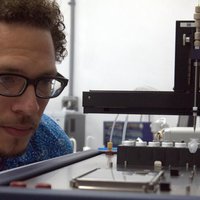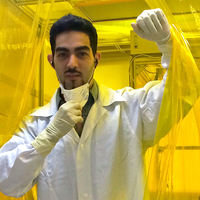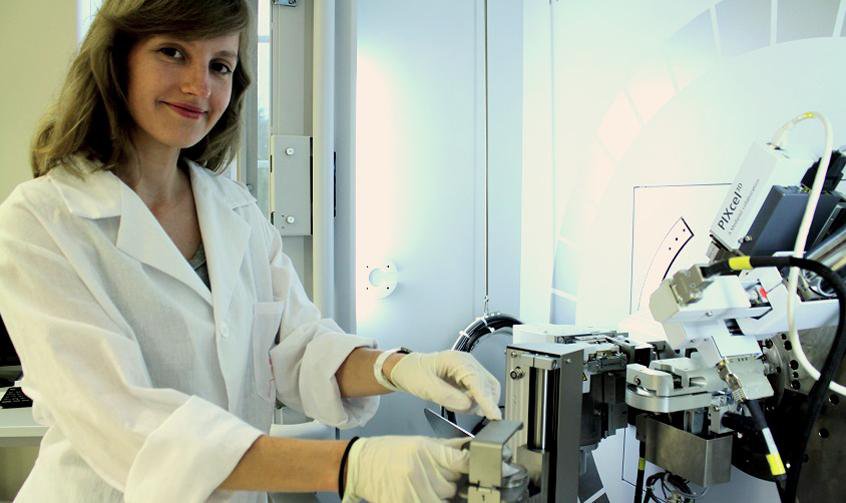"A world where the most advanced solar technology can be purchased by the meter at the supermarket, installed in two minutes without the help of a technician, and disintegrate at the end of its life cycle; this is the world that the young, Polish innovator Olga Malinkiewicz dreams of. A materials scientist and entrepreneur, Olga gave up her postdoctoral studies at the University of Linköping (Sweden) in September, 2014 to found the company Saule Technologies and pursue her dreams. To this end, this young woman focused on taking a mineral that could revolutionize the solar energy industry, perovskite, to the mass market.
The advances of this prodigious material are derived from its crystalline structure, which maintains its solar properties irrespective of the components from which it is made. Several research groups are working with perovskites containing three components: one organic compound, like amines; one inorganic compound, ions from lead or another metal, which make them good semiconductors; and finally a halide compound, which can be modified to produce different colored materials.
Pervoskites have a very high energy absorption coefficient of visible light, which could oust the components currently used to construct solar panels. According to Malinkiewicz, perovskites “even exceed, by an order of magnitude, the coefficient of gallium arsenate”, one of the best – and most expensive – absorbents in the solar industry, as well as the coefficient of crystalline silicon, the current market leader.
Within a solar cell, the perovskites are sandwiched between other materials, and they are constructed atop a substratum, often made of glass. Saule Technologies has managed to produce solar cells using this material, whose processing does not require elevated temperatures, allowing them to be imprinted onto thin and flexible substratum like plastic or even paper. “The fact that perovskites have an organic component makes them soluble, which allows us to make ink with them and use them to print”, the young woman explains.
In December, 2014, Malinkiewicz presented her inkjet printing manufacturing process for perovskite sheets in Boston (USA). Since then, her efforts have focused on improving this process, testing its resistance to aging (and to water), and achieving a larger printed surface (instead of a mere few square centimeters). Another challenge resides in the substitution of lead by another component, one which does not entail environmental concerns and does not encapsulate the material.
Although this technology “is not attractive” to many groups because “it requires time for testing and improvements before results can be achieved”, Malinkiewicz says that “once we have optimized the process and the sheets, we will be able to print meters upon meters, in whatever shape you like, and still maintain efficiency”.
Currently, solar cells are made from plastic overlaid on a flexible substrata, but just as this young innovator points out, its efficiency “never exceeds 8%”. The perovskite solution could reach efficiency levels of 20%, thanks to the excellent light absorption properties of this material and its highly conductive nature, similar to that of silicon. For now, Saule Technology´s solar cells have accomplished 3% efficiency and are expected to reach, or surpass, 10% efficiency within the next two years.
Malinkiewicz wants to see the day when anyone will be able to purchase half of one square meter of perovskite sheet, stick it to the living room window, and connect a cable to start obtaining cheap and clean energy without installation costs. After a few years, it would simply disintegrate without generating non-recyclable residues. Another advantage posed by this technology is that it would allow Europe to compete with China for control of the photovoltaic industry. “If you make truly cheap perovskites, it would be impossible to make them at lower cost given that the transportation costs will be higher”, Malinkiewicz affirms. To achieve this it will be necessary to lower the price sufficiently and find a way to manufacture it quickly without sacrificing its excellent properties.
Robert Dwilinski, Director of the Office of Technological Transference at University of Warsaw (Poland) and jury member for MIT Technology Review´s Innovators Under 35 Poland competition, says that Malinkiewicz has developed a new technology that could spark a “social revolution” in renewable energies and “she´s on the right path for an effective [knowledge] transfer from academia to industry”."




